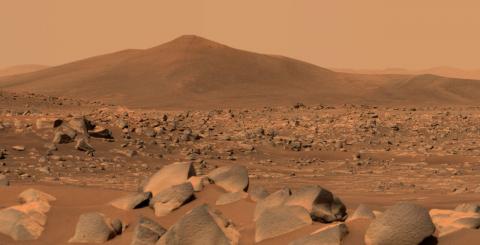Reactions to the discovery of an RNA component on the asteroid Ryugu
A Japanese research team has announced in Nature Communications that it found uracil, a component necessary to form RNA, in a small sample collected from the asteroid Ryugu. According to the authors, these results indicate that these molecules of prebiotic interest were commonly formed on asteroids like Ryugu, and reached the early Earth with the impact of these bodies. The sample was collected by the Japan Aerospace Exploration Agency's Hayabusa2 robotic spacecraft, which returned to Earth in December 2020.

NASA Goddard/JAXA/Dan Gallagher
Izaskun Jimenez - uracil ryugu EN
Izaskun Jiménez Serra
CSIC staff scientist, specialised in the chemistry of prebiotic molecules in the interstellar medium
This is an exciting discovery since it reveals that uracil, one of the nucleobases of RNA, can be synthesized in space. This implies that significant amounts of uracil could have become available on primitive Earth through the impact of meteorites during the Late Heavy Bombardment period between 4100 and 3800 million years ago, triggering the first biochemical processes that led to the origin of life.
César Menor - uracil Ryugu EN
César Menor Salván
Astrobiologist and lecturer of Biochemistry at the University of Alcalá
We (astrobiologists who study prebiotic chemistry) had been awaiting the results of the Ryugu samples analysis for a long time. This study is great news and, at the same time, it leaves us wanting to know more.
First of all, it should be made firmly clear that confirming the presence of molecules such as uracil in Ryugu-type asteroids does not answer essential questions about the origin of life. Nor does it in any way suggest that the input of organic matter from space was necessary for the origin of life on Earth. This is a common misinterpretation in the media when such results are presented. This work does not support any panspermia hypothesis, nor does it indicate that life or its components had to come from space or that meteorite impacts were necessary for it. The fact that there is uracil on an asteroid does not help to better understand how life originated. The apparent paradox is that this is, however, a very interesting piece of research.
This work is important, in my opinion, for two reasons. First, because the results of Ryugu's analysis are not surprising, and are consistent with previous analyses of carbonaceous chondrite meteorites, and with what we know about the chemistry of these materials.
This means that our prebiotic chemistry laboratory models are valid, and that we have the ability to predict the organic composition of extraterrestrial objects. A big surprise would have been if uracil and related molecules were not present in the sample. That would imply that all our efforts in the lab do not represent reality. So finding uracil (among many other things) in Ryugu supports the work of experimental scientists; in particular, the work of my team, because this study on the Ryugu samples has taken into account our models of prebiotic chemistry.
The research, as is often the case, leaves us with more questions than answers: limitations in the analysis do not allow us to see other expected components, and it raises questions about the chemical differences between the asteroid's surface, exposed to intense radiation, and its interior, with a higher water content and shielded from radiation.
So we eagerly await the results of the analyses of the asteroid Bennu, where we expect Professor Oba and his team to expand the catalogue of nitrogenous molecules present, and to search for specific components that we have suggested and consider to be of interest in the study of the origin of life.
Secondly, this work is historic and represents a milestone in space research: the ability to collect pristine samples on the surface of another body in the Solar System, return them to Earth and analyse them in detail is a major technological achievement. It is also a very technically challenging analysis, as the samples are very small and the components studied are in very low concentration. The team faced a complex challenge: is the presence of uracil in the sample real or the result of contamination on Earth?
In my opinion, the analyses performed are robust, well controlled and demonstrate, with little doubt, that the molecules found are genuine and not the result of contamination. This demonstrates the ability of the Japanese space agency to not only recover the samples from space, but to establish a reliable protocol for safekeeping, handling and avoiding contamination that would make the samples unusable for this purpose.
Yasuhiro Oba et al.
- Research article
- Peer reviewed



